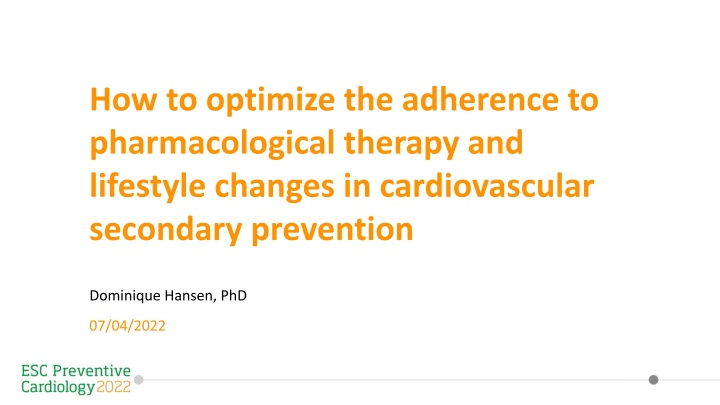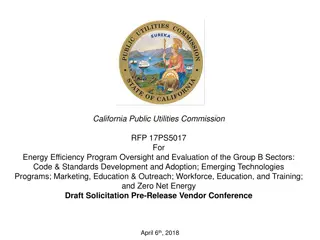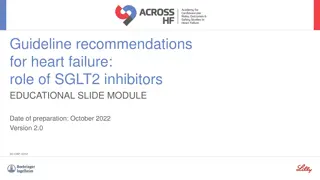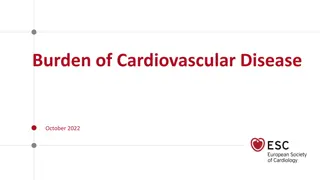
Maximizing Adherence to Cardiovascular Secondary Prevention Measures
Explore strategies to optimize adherence to pharmacological therapy and lifestyle changes in cardiovascular secondary prevention. Insights from EUROASPIRE surveys highlight challenges, predictors of non-adherence, and the importance of improving patient-centered care. Discover effective approaches to enhance guideline-directed secondary prevention measures in cardiology.
Download Presentation

Please find below an Image/Link to download the presentation.
The content on the website is provided AS IS for your information and personal use only. It may not be sold, licensed, or shared on other websites without obtaining consent from the author. If you encounter any issues during the download, it is possible that the publisher has removed the file from their server.
You are allowed to download the files provided on this website for personal or commercial use, subject to the condition that they are used lawfully. All files are the property of their respective owners.
The content on the website is provided AS IS for your information and personal use only. It may not be sold, licensed, or shared on other websites without obtaining consent from the author.
E N D
Presentation Transcript
How to optimize the adherence to pharmacological therapy and lifestyle changes in cardiovascular secondary prevention Dominique Hansen, PhD 07/04/2022
Current adherence to secondary prevention measures EUROASPIRE survey 42% of patients hypertensive 46% of diabetics HbA1c >7.0% 71% of patients LDL-c >1.8 mmol/l Kotseva K, et al. Lifestyle and impact on cardiovascular risk factor control in coronary patients across 27 countries: Results from the European Society of Cardiology ESC-EORP EUROASPIRE V registry. Eur J Prev Cardiol. 2019;26:824-35
Current adherence to secondary prevention measures EUROASPIRE survey 50% still smokes 38% still obese 60% insufficiently active De Bacquer D, et al. Poor adherence to lifestyle recommendations in patients with coronary heart disease: results from the EUROASPIRE surveys. Eur J Prev Cardiol 2022;29:383-95.
Central theme of clinical consensus statement Adherence to guideline-directed secondary prevention measures in cardiology: how to optimise this?
Whats in a name? Adherence The extent to which a person s behaviour taking medication, following a diet, physical activity recommendation, and/or adopting or having a heart-healthy lifestyle - corresponds to agreed recommendations from a healthcare provider. Intentional vs. unintentional non-adherence Clinically relevant problems with treatment adherence represent a specific mental disorder that needs to be diagnosed and treated (ICD-10/ICD-11: F54/6E40)
Predictors of non-adherence Low risk perception Low health literacy Poor coping skills Poor social support Mental disorders (e.g. depression,mood disorder, anxiety, personality disorder) General therapy adherence predictors Patient-centred barriers Disease-driven barriers Clinician-centredbarriers Medication-driven barriers Healthcare system-driven barriers Specific predictors of lower therapy adherence Good intake assessment is key
poor motivation environmental, societal and social pressures lack of time health and physical limitations negative thoughts and moods socioeconomic constraints gaps in knowledge or awareness lack of enjoyment of exercise poor early weight loss greater baseline BMI having existing cardiometabolic comorbidities being female younger age Predictors of non-adherence Overweight/obesity General therapy adherence predictors lower diastolic blood pressure higher cost or insurance type/coverage non-white or non-Hispanic race/ethnicity fewer healthcare contacts after the prescription 4 comorbidities distrust, (concern for) side effects lack of perceived need for treatment Patient-centred barriers Disease-driven barriers Clinician-centredbarriers Hypertension Medication-driven barriers female sex younger age absence of MI or stroke, diabetes, hypertension, co-morbidities negative beliefs about medicines prolonged treatment lack of symptoms related to dyslipidaemia Healthcare system-driven barriers Specific predictors of lower therapy adherence Dyslipidaemia anxiety diabetes distress older age poor communication with clinicians stress concerns about medicines cognitive impairment low levels of self-care frequent hypoglycaemia Diabetes lack of social support absence of symptoms cognitive decline adverse reactions depression poor attention span poor knowledge about medication or treatment prescription of multiple medications difficulty with swallowing (large) pills CAD and HF transportation difficulties lack of referral by health care providers lack of supervision lack of social support from staff and peers no individualization lack of enjoyment Elderly
What to do? Actions on the five dimensions of adherence to therapy
What to do? The patient Provide additionalpsychosocial support Optimizehealth literacy Empower the patientand increase the patient sself-efficacy Actions on the five dimensions of adherence to therapy
What to do? The patient Provide additionalpsychosocial support Optimizehealth literacy Empower the patientand increase the patient sself-efficacy Actions on the five dimensions of adherence to therapy The healthcareprovider Provide correct, timelyand sufficient information Apply shared decision making Improve communicationskills Optimizethe patient srisk perception Optimizeclinicalinertia Be with your therapy
What to do? The disease The patient Be aware of low adherence predictors in different diseases Provide additionalpsychosocial support Consider graded therapy in multimorbidity Optimizehealth literacy Prevent frequent change in therapy (in multimorbidity) Empower the patientand increase the patient sself-efficacy Actions on the five dimensions of adherence to therapy The healthcareprovider Provide correct, timelyand sufficient information Apply shared decision making Improve communicationskills Optimizethe patient srisk perception Optimizeclinicalinertia Be with your therapy
What to do? The disease The patient Be aware of low adherence predictors in different diseases Provide additionalpsychosocial support Consider graded therapy in multimorbidity Optimizehealth literacy Prevent frequent change in therapy (in multimorbidity) Empower the patientand increase the patient sself-efficacy Actions on the five dimensions of adherence to therapy The healthcareprovider The healthcaresystem Provide correct, timelyand sufficient information Make access to healthcare easy, rapid, efficientand affordable Apply shared decision making Implementcommunity-based programs/interventions Improve communicationskills Proper socialmedia coverage can assist in therapy adherence Optimizethe patient srisk perception Informal caregivers can be involvedmore often Optimizeclinicalinertia Be with your therapy
What to do? The disease The patient Be aware of low adherence predictors in different diseases Provide additionalpsychosocial support Consider graded therapy in multimorbidity Optimizehealth literacy Prevent frequent change in therapy (in multimorbidity) Empower the patientand increase the patient sself-efficacy Actions on the five dimensions of adherence to therapy The healthcareprovider The healthcaresystem Provide correct, timelyand sufficient information Make access to healthcare easy, rapid, efficientand affordable Apply shared decision making Implementcommunity-based programs/interventions Improve communicationskills Proper socialmedia coverage can assist in therapy adherence The therapy Optimizethe patient srisk perception Informal caregivers can be involvedmore often Prefer the poly-pilltreatment Optimizeclinicalinertia Intensify/increase the use of mhealth and e-health Be with your therapy
Thank you for your attention Roberto F.E. Pedretti, Dominique Hansen, Marco Ambrosetti, Maria Back, Thomas Berger, Mariana Cordeiro Ferreira, V ronique Cornelissen, Constantinos H. Davos, Doehner Wolfram, Carmen de Pablo y Zarzosa, Ines Frederix, Andrea Greco, Donata Kurpas, Matthias Michal, Elena Osto, Susanne Pedersen, Rita Esmeralda Salvador, Maria Simonenko, Patrizia Steca, David R. Thompson, Matthias Wilhelm, Ana Abreu


















